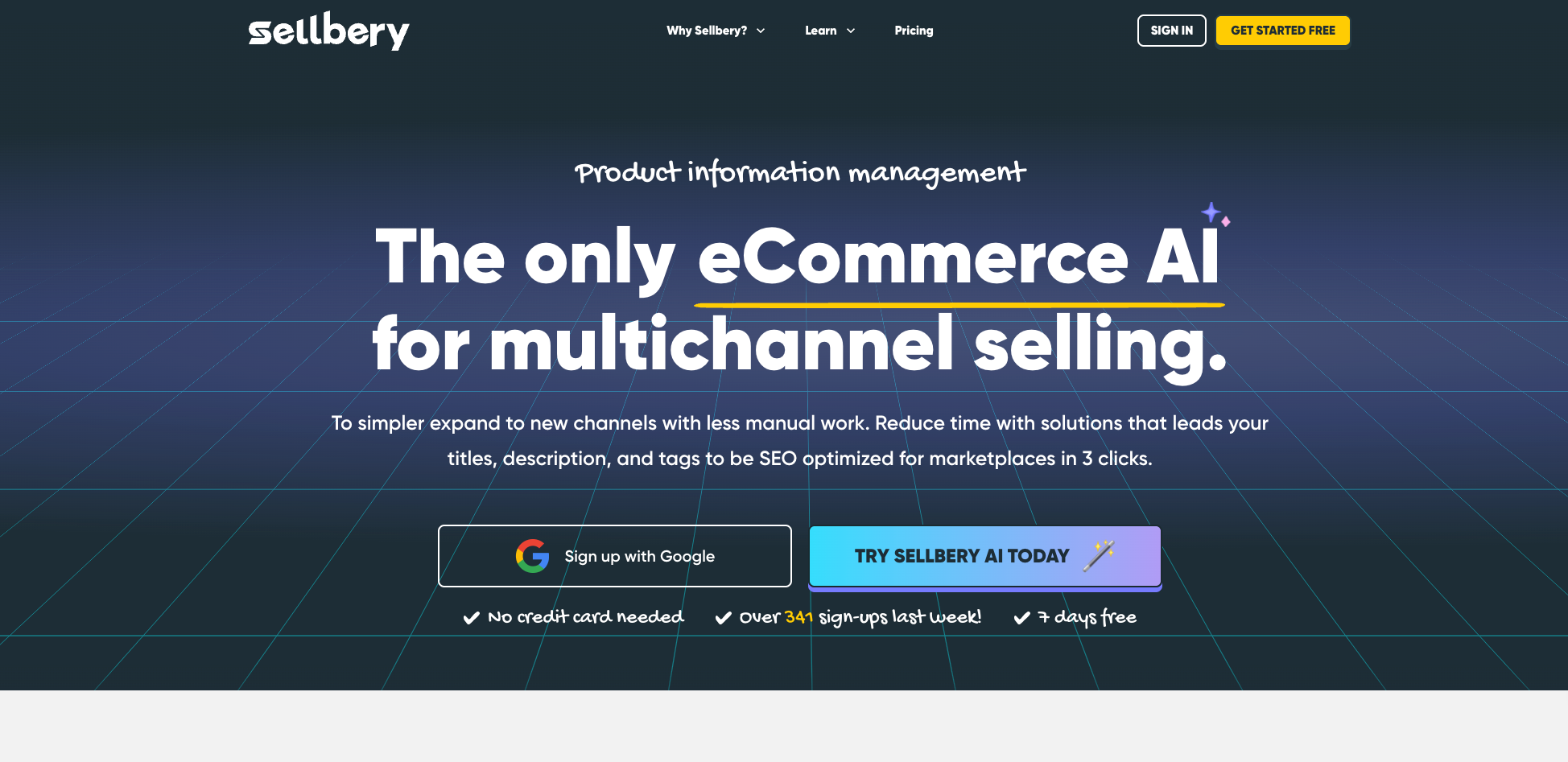I’ve spent years advising online merchants on how to manage their product feeds, keep inventory in check, and scale successfully across marketplaces. Every so often, I’m asked about Sellbrite and whether there are comparable or better solutions out there.
The short answer? Absolutely. Sellbrite is a solid platform, but it is far from the only option.
In this piece, I’ll discuss eight Sellbrite product feed alternatives that I’ve reviewed, tested with clients, and found to work well in different situations.
But before we get into it, here is a quick overview of the tools included in this list:
Why Look for Alternatives?
There are many reasons to consider options beyond Sellbrite. I believe it is smart to try different technology solutions if the current one does not meet your needs.
If the support is lacking, features are missing, or the pricing isn’t right, it makes sense to see what else is available.
Even if you’re only partially happy with Sellbrite, looking at other solutions can reveal useful features you never knew existed or business models that suit your store’s size and budget better.
A friend who owns a small but fast-growing e-commerce brand switched from Sellbrite to a specialized platform with advanced analytics.
That switch made a significant difference to his bottom line because he found a solution tailored exactly to his requirements.
Throughout this article, I explain the top eight alternatives, each with its own benefits, drawbacks, and quirks that might fit well with your operation.
1. SEO.AI

I’ll start by mentioning SEO.AI. Yes, I work at SEO.AI, so it might not be surprising to see this tool on the list.
However, it genuinely stands out for its ability to write and optimize all types of content—product descriptions, meta tags, category pages, and more—backed by data-driven insights to align with Google’s algorithm.
Whether you’re running a small website, a large e-commerce business, or something in between, SEO.AI combines strong AI capabilities with feed optimization, making it one of the best solutions I’ve encountered.
Why SEO.AI is Different
- AI-Powered Content and Feed Optimization: The platform’s AI assists in generating and enhancing descriptions, titles, and attributes. By analyzing keyword data and performance metrics, SEO.AI helps you build product feeds that catch both shoppers’ attention and search engine algorithms.
- Built-In SEO Score and AI Chat: SEO.AI’s real-time scoring system tells you exactly what to do when generating new content or optimizing existing listings. Plus, the in-line AI Chat eliminates the need for constant copy/paste or tab switching.
- Brand Voice Training: You can train the AI to understand your brand’s tone of voice. This means less time editing and more time listing your products accurately and consistently across multiple channels.
Who It’s Best For
If you need a comprehensive solution that combines feed optimization with SEO insights, SEO.AI is a top pick.
It speeds up the process of creating hundreds (or thousands) of product descriptions while ensuring each is tailored to rank well.
Whether you’re an SEO-savvy merchant or a creative marketer, the data-driven approach and automated features help you work faster and more effectively.
2. Webgility

When I first heard about Webgility, it was mostly presented as an accounting solution.
Many people talked about how well it synchronized with QuickBooks. Once I looked further, I realized Webgility is more than just a finance integration tool—it is a full feed management and inventory platform.
Standout Features
- Strong Accounting Integration: Webgility’s main advantage is how it automates many back-office tasks. You can track every sale, return, and fee across all channels, and have that data accurately reflected in your records.
- Easy-to-Use Dashboards: Unlike some feed tools that feel clunky, Webgility offers a clear interface and customizable dashboards. You can set up alerts for overselling or incorrect listings.
- Multi-Channel Sync: It isn’t limited to one storefront. Whether you’re on Shopify, Amazon, eBay, or another platform, Webgility’s features keep your product feeds consistent.
Many retailers who have issues with scattered accounting processes have found Webgility very helpful. The integration with QuickBooks is excellent, making it easy to avoid manual data entry and reduce errors.
Who It’s Best For
If you run a small-to-midsize store and want to simplify your accounting while keeping all sales channels updated, Webgility is a solid option. It takes care of invoices, shipping fees, taxes, and other details.
3. Multiorders OMS

Multiorders OMS caught my attention because of its simple appearance.
I admit I was a bit cautious at first—many tools claim to be easy to use but end up complicating things.
However, Multiorders OMS lives up to its description with an interface that remains clear even when you add more channels or shipping carriers.
My Experience with Multiorders OMS
I remember helping a friend’s small fulfillment company start using Multiorders. He needed something straightforward: track orders from multiple marketplaces, manage shipping carriers in one place, and avoid running out of stock. Multiorders delivered on those points.
- Inventory and Order Management: If keeping accurate inventory across Amazon, eBay, and your own site is a concern, Multiorders is worth checking out.
- Shipping Carrier Integrations: The platform supports many carriers. With a few clicks, you can compare shipping rates and print labels automatically.
- Simplicity Over Complexity: The system does not force advanced features you may not need, although you can add more as your business grows.
While it may lack some of the detailed analytics or feed customization features found in other tools, if you prefer a system that keeps costs low and processes straightforward, Multiorders could be the right choice.
4. SellerActive by Cart.com

SellerActive, especially after working with Cart.com, has become a well-known name in e-commerce discussions. It is known for being feature-rich, with tools that are regularly improved based on user feedback.
Key Highlights
- Supports Multiple Channels: SellerActive integrates well with Amazon, eBay, Walmart, and more. If you sell on several platforms, this solution helps keep your feeds consistent.
- Automatic Repricing: This feature is important in competitive marketplaces. SellerActive can adjust your prices in real time, staying on top of competitor changes without you having to make manual updates.
- Custom Feeds: It lets you set up specific feed formats, tailor your data, and adapt product listings to the best practices of each channel.
I have seen businesses grow comfortably with SellerActive. A mid-sized merchant mentioned that her monthly costs stayed the same even when she increased her product catalog substantially. That was largely because SellerActive’s automation managed the growing number of listings so efficiently.
Things to Consider
The price can be higher than simpler solutions, which might discourage very small businesses.
Also, the wide range of features can seem overwhelming for beginners. If you prefer a very simple tool, you might consider a more basic platform.
5. FeedHub by OneCommerce

FeedHub focuses on feed optimization and localization. Many feed tools offer basic analytics, but FeedHub provides detailed, AI-driven recommendations.
Why FeedHub is Different
- AI-Driven Optimization: Part of the tool uses artificial intelligence to suggest changes in product titles, descriptions, or even categories with the goal of boosting search visibility and conversions.
- Localization: If you sell in multiple countries, you might appreciate how FeedHub can handle currency conversions, update shipping estimates by region, and even adjust titles or descriptions for different markets.
- User-Friendly Interface: One feature I appreciate about FeedHub is that it keeps advanced tools available without a crowded interface. The dashboard stays intuitive.
FeedHub appeals to businesses that want to improve product listings to do better against the competition.
It provides clear analytics on each listing’s performance and suggests adjustments on the fly. I once helped a store optimize thousands of SKUs for international customers. What used to be a manual process became faster and more accurate with FeedHub’s automation.
6. Plytix

Plytix takes a different approach by focusing primarily on Product Information Management (PIM).
While most feed management tools concentrate on syncing data to sales channels, Plytix is all about how you store and organize your core product information.
What Makes Plytix Different
- Centralized Data Hub: With Plytix, all your product information—images, attributes, descriptions, metadata, and more—is kept in one place. This ensures consistency whether you’re updating one channel or many.
- Data Enrichment: If you want to improve product descriptions, include region-specific keywords, or add multiple images, Plytix provides tools to keep that data organized and ready to publish.
- Team Collaboration: If you have team members who frequently update product data, such as copywriters, photographers, and product managers, Plytix facilitates collaboration by providing a single shared database.
Keep in mind, Plytix does not typically manage logistics or order management.
That means you may need another system to handle shipping, fulfillment, or accounting. However, if you have products that change frequently or are complex, Plytix’s focus on the quality of the product information may be exactly what you need.
7. Ecomdash

Ecomdash has been around for a long time and is often recommended to smaller businesses that need to centralize listings without a large investment. If you have a tight budget or are new to selling on multiple channels, Ecomdash might be a practical starting point.
Pros & Cons in a Nutshell
Pros:
- Budget-Friendly Plans: There is usually an Ecomdash plan that won’t strain your finances.
- Multi-Channel Features: The solution covers basic feed management, inventory syncing, and listing tools.
- Ease of Use: Its interface is simpler than what some larger players offer.
Cons:
- Fewer Advanced Features: If you need in-depth analytics, robust automation, or specialized functionality, Ecomdash might fall short.
- Keeping Up with New Integrations: New marketplaces or shipping platforms may not get prompt support.
One small client used Ecomdash to manage around 500 SKUs across Etsy, Amazon, and her own Shopify store.
She found that it significantly improved her control over orders and stock levels. As she expanded and added more channels, however, she eventually transitioned to a different platform. In her early stage, though, it worked well as a cost-effective solution.
8. Sellbery

Sellbery is sometimes seen as a competitor because it offers similar features—centralizing listings, syncing data, and showing all information in one place.
A big advantage is typically its lower price compared to Sellbrite.
The Upsides
- Easy to Get Started: You can connect your store and marketplaces without much hassle.
- Reliable Inventory Sync: If keeping stock levels consistent is your main challenge, Sellbery’s checks can be very useful.
- Low Cost: This is attractive for newer businesses or anyone looking for a more affordable alternative.
The Downsides
- More Basic Order Management: You may have to log into individual marketplaces like Amazon or eBay to complete fulfillment.
- Fewer Integrations: If you plan to expand significantly or require specialized shipping integrations, Sellbery’s features might feel limited.
I have seen Sellbery work well for merchants who just need the essentials of feed syncing across a few channels.
Provided you are comfortable handling order management with other tools or manually within marketplaces, Sellbery can help reduce costs.
Quick Feature Comparison
I like to see how each tool stacks up against Sellbrite. Here is a table comparing key features:
Want to try the #1 AI Toolkit for SEO teams?
Our AI SEO assistants helps write and optimize everything - from descriptions and articles to product feeds - so they appeal to both customers and search engine algorithms. Try it now with a free trial→

![8 Sellbrite Product Feed Alternatives [Updated]](https://cdn.prod.website-files.com/627a5f477d5ec9079c88f0e2/6613aaaa53d5b53093f7b8b3_oskar-mortensen.jpg)










